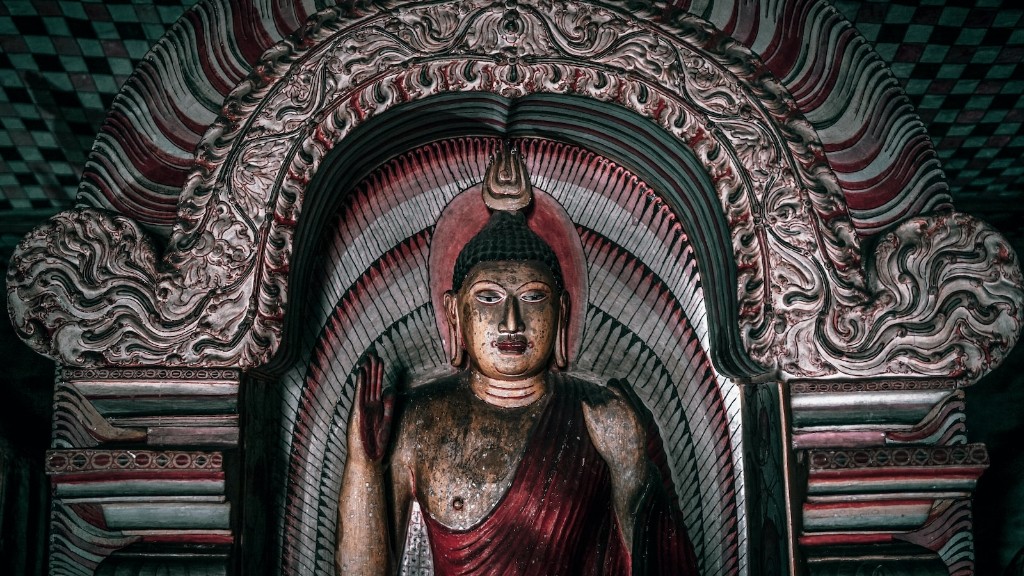Origins of Hinduism and Buddhism
Hinduism and Buddhism are two distinct religions that developed in South Asia. Hinduism, one of the oldest of the world’s major faiths, is believed to have originated in ancient India. The Hindu traditions, beliefs and practices, as well as its textual sources and scriptural understandings, have evolved over time. Buddhism has its major roots in Hinduism, and is believed to have sprung up in India roughly 2,500 years ago. The key distinction between the two religions is that while Hinduism is predicated upon a belief in the Vedas and its philosophy of the soul, Buddhism is based upon the elements of meditation and mindfulness.
Until the early 19th century, Hinduism and Buddhism were inseparable in the Indian context. They were frequently discussed together and were believed to have been developed out of the same spiritual and philosophical thought process. Traditional Hindu texts also revealed traces of Buddhist teachings. Scholars suggest a symbiotic relationship between the two religions as both of them influenced each other during their development.
Differences between Hinduism and Buddhism
In spite of their similarities, there are a few notable differences between Hinduism and Buddhism. Hinduism is somewhat more orthodox, is based on a spiritual hierarchy and upheld by the concepts of dharma and karma. Buddhism is based on a monastic lifestyle and focused on the four great “noble truths”. Dharma, in contrast to Hinduism, is oriented around the idea of mindfulness. The Buddha taught that enlightenment is obtained through meditation, while karma in Buddhism is viewed in terms of the cause and effect of action. Buddhism emphasizes on self-reflection, wisdom and compassion, whereas Hinduism focuses on the spiritual connection between souls and the concept of rebirth.
How Hinduism Influenced Buddhism
Hinduism had a great influence on the development and teachings of Buddhism. From the start, Buddhism found its origin within Hinduism’s principles and its philosophy of the soul. The Buddha famously meditated and studied different spiritual approaches while adopting them and adding his own interpretations. He later used his knowledge to create the Eightfold Path, which refers to “right speech,” “right action,” and “right livelihood”. This is the essence of Buddhism itself, which is derived from Hinduism.
Hinduism also helped to shape certain central aspects of Buddhism, such as the idea of reincarnation. According to Buddhism, any individual’s ultimate aim is to attain enlightenment, cease the cycle of reincarnations, and escape the cycle of suffering. This outlook is ultimately grounded in Hinduism since its concept of karma is critical to understanding the Buddha’s teachings. The Hindu doctrine states that one’s actions in this lifetime can lead to consequences in the next.
Other fundamental Buddhist beliefs, such as karma and the four noble truths were also derived from Hinduism and its doctrine of ahimsa, which prohibits causing harm to any living being. Buddhism also inherited from Hinduism the concept of maitri, which involves developing respect and love for those around us. The teachings of both religions also seem to have developed and been motivated by the concept of Dharma, which refers to an inner consciousness that encourages one to uphold good values.
Hinduism’s Influence on Buddhism’s Rituals
Hinduism has had a direct influence on certain ritualistic aspects of Buddhism. A prominent example is the ritual of meditation. This practice is part of many forms of Buddhism and draws upon Hindu Vedic methods, such as Transcendental Meditation (TM). Buddhists also light butter lamps after rituals, which is a practice borrowed from Hinduism. Similarly, during prayer rituals in Buddhism, Homa – a Hindu practice, is often followed. Chanting of mantras is another example which has been derived from Vedic Hinduism and is a vital part of Buddhist rituals.
Moreover, the worship of Hindu gods, such as Shiva and Vishnu, is a key aspect of Buddhism. Some of the older Buddhist texts reflect this, with the Buddha being depicted as an incarnation of Vishnu. Buddhists also use murtis, statues or images of the Buddha, Shiva, or others, to express their devotion and reverence. Hindu rituals such as the Brahmacharya, Pranayama and the Upanayana are also observed within some branches of Buddhism.
Global Influence of Hinduism and Buddhism
Hinduism and Buddhism have both had a great influence not just on South Asia, but on the entire world. Both religions have inspired many great writers, thinkers and spiritual leaders across various cultures and traditions. A prominent example of this is Mahatma Gandhi, who combined Hindu and Buddhist ideologies and principles to promote non-violent protests and resistance. Even today, both religions continue to command a great following, impacting millions of lives around the world.
Final Remarks
It is clear that the two religions have had a significant impact on each other over time. The teachings of Hinduism have left an unmistakable imprint on Buddhism, heavily influencing its spiritual practices and beliefs. This is reflected even today in the way Buddhist ritualism and meditation have found its roots in Hinduism. The spread of Hinduism and Buddhism to different parts of the world has opened up new pathways to understanding the connection between the two religions and their underlying philosophies.
